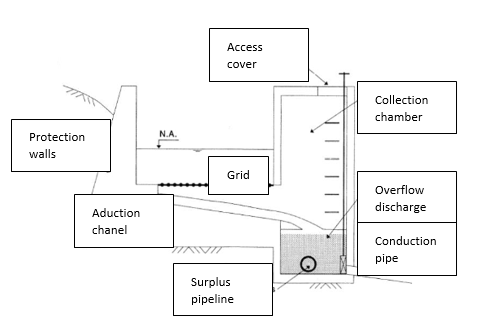Intakes:
An intake is a hydraulic structure designed to divert part of the available water from a watercourse (river, stream, or canal), from a lake or even from the sea. Technically, intakes generally consist of the following parts:
– Control gate and gate closure.
– Device for measuring levels upstream and downstream of the control gate. These may be simple graduated rulers or may have continuous level gauges and transmitters of the information to the operating centre, which may have mechanisms to remotely operate the gate.
The most common types of intakes are lateral and bottom intakes. The main difference between these two types of intakes is the location of the intake point in relation to the water flow. A more detailed description of both types is presented below:
Lateral Intake
As its name indicates, this type of intake is located on one side of the stream from which the water is being captured. According to their location, they are classified into curved side intakes and straight side intakes. The lateral intakes in straight sections are more recommended, since they present less vulnerability to flooding of the river and erosive processes.
However, if capture is necessary in a curve, the intake must be located on the outside of it to avoid the accumulation of sediment that frequently occurs in internal curves, and it must have the necessary protection walls to avoid damage by erosion and scour, which are frequent in external curves.
Bottom Intake

The bottom intakes have certain similarities with respect to the lateral ones, such as the presence of a dam in order to raise the level of the water sheet at the intake point. However, its main difference, as its name implies, is that the collection grid is located horizontally and below the flow of the stream.
The water that passes through the grid reaches a channel that takes it to the collection chamber, from where it can be carried by gravity or pumping to the next process.
Floating Intake

A floating intake corresponds to a pumping system that is installed on top of a floating surface (slab), which is supported by guide rails or by chains, anchored to the bottom of the body of water, and which allows to capture raw water from pondages or rivers whose level can change rapidly. Since the intake point is integral and fixed with the pumping station, it will always capture the water at the same depth below the float level of the slab. The captured water is sent through a flexible pipe to the pre-treatment or water treatment system.
Bibliography
Diseño hidráulico de acueductos menores. 2020. IBAL. | https://www.ibal.gov.co/sites/default/files/ibal/sites/default/files/images/stories/Dise%C3%B1o%20hidraulico%20de%20acueductos.pdf
Referencies
Generalidades del diseño de obra de captación a partir de toma lateral. | Obra de captación de toma lateral